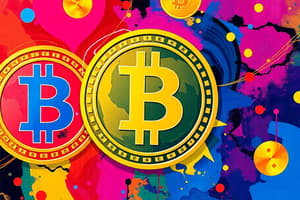Podcast
Questions and Answers
Which of the following scenarios would most likely lead to a token being considered a positive indicator for investors, based on its utility within its ecosystem?
Which of the following scenarios would most likely lead to a token being considered a positive indicator for investors, based on its utility within its ecosystem?
- The token grants voting rights in the project's development decisions. (correct)
- The token's primary function is to serve as a store of value, similar to precious metals.
- The token is used exclusively for speculative trading on decentralized exchanges.
- The token's availability is limited and diminishing, creating scarcity in the market.
An investor is evaluating a Proof of Stake (PoS) cryptocurrency and discovers that a significant portion of the tokens is held by a small group of early investors. Which of the following risks should the investor be most concerned about?
An investor is evaluating a Proof of Stake (PoS) cryptocurrency and discovers that a significant portion of the tokens is held by a small group of early investors. Which of the following risks should the investor be most concerned about?
- Potential for centralization and manipulation of the network. (correct)
- Decreased volatility in the token's price due to long-term holding.
- Higher transaction fees as a result of increased network congestion.
- Increased network security due to the high value of staked tokens.
A cryptocurrency project employs a token burning mechanism. How does this process typically influence the token's value and scarcity?
A cryptocurrency project employs a token burning mechanism. How does this process typically influence the token's value and scarcity?
- Token burning has no impact on the token's value or scarcity.
- Token burning increases scarcity, potentially raising the token's value. (correct)
- Token burning increases the circulating supply, diluting the token's value.
- Token burning decreases scarcity, leading to lower demand.
What is the most significant implication of a cryptocurrency project failing to comply with local and international regulations?
What is the most significant implication of a cryptocurrency project failing to comply with local and international regulations?
How might the existence of forks in a blockchain project influence an investor's decision-making process regarding the project's tokenomics?
How might the existence of forks in a blockchain project influence an investor's decision-making process regarding the project's tokenomics?
Flashcards
What is Tokenomics?
What is Tokenomics?
The financial structure of a cryptocurrency, defining how tokens work within a blockchain ecosystem.
What is Total Supply?
What is Total Supply?
The maximum number of tokens that will ever exist for a cryptocurrency.
What is Token Distribution?
What is Token Distribution?
How tokens are allocated among stakeholders like developers, investors, and reserve funds.
What is Token Utility?
What is Token Utility?
Signup and view all the flashcards
What is Token Security?
What is Token Security?
Signup and view all the flashcards
Study Notes
Tokenomics Overview
- Tokenomics is the financial structure of a cryptocurrency.
- Understanding tokenomics helps investors make informed decisions within a blockchain ecosystem.
- Tokenomics involves grasping the purpose, functionality, and strategic design of a token.
- It can be seen as the DNA of a cryptocurrency.
- Tokenomics can impact the total supply, distribution, security, and usage of tokens.
- Poor tokenomics can result in investment losses, while a well-thought-out design can lead to success.
Key Components of Tokenomics
- Total Supply: The maximum number of tokens that will ever exist for a cryptocurrency; introduces scarcity.
- Limited token supply can increase demand and value, like Bitcoin's capped supply of 21 million.
- Distribution: How tokens are allocated among stakeholders like developers, investors, and the community.
- A transparent and fair distribution model is crucial for maintaining trust within the ecosystem so as not to concentrate power or wealth and make the token susceptible to manipulation.
- Initial coin offerings (ICOs) often detail token distribution, which is vital for assessing a token's long-term viability.
- Utility: Describes the functionality and purpose of a token within its ecosystem and can provide insights into its intrinsic value.
- Security: Measures in place to protect the token and the overall network, including consensus mechanisms like Proof of Work or Proof of Stake.
How to Analyze Tokenomics
- Research Whitepapers: Most crypto projects outline their tokenomics in a whitepaper.
- Thoroughly understand the philosophy, technology, and mechanics behind the token.
- Check Community Engagement: A vibrant community signifies strong support for the project's mission.
- Gauge community pulse through forums, social media, and meet-ups to get insights on potential concerns.
- Evaluate Utility and Demand: Determine if the token serves a unique function and assess its real-world application.
- Consider the Economic Models: Projects may use economic models like inflation, deflation, or hybrid approaches.
- Different economic models influence how a token's value might behave over time, e.g., deflationary models may increase value as supply decreases.
- Examine Regulatory Compliance: Confirm project adherence to local and international regulations to minimize legal risks.
Examples of Tokenomics
- Bitcoin (BTC) has a total supply of 21 million, distributed through mining, used as currency, and secured by Proof of Work (PoW).
- Ethereum (ETH) has no hard cap (total supply), is distributed through mining (also pre-mined), offers smart contracts, and transitions from PoW to Proof of Stake (PoS) for security.
Mistakes to Avoid
- Ignoring the Whitepaper
- Following the Crowd
- Overlooking Security
Actionable Steps for Investors
- Study the Whitepaper
- Engage with the Community
- Evaluate Real-World Utility
- Consult a Financial Expert if Needed
Frequently Asked Questions
- Tokenomics can change after a project's launch and impact token value, utility, or distribution.
- Can verify authenticity by referring to official sources, participating in community forums, and reaching out to the team directly.
- Forks might affect supply, demand, utility, and overall value.
- Token burning (destroying tokens) and minting (creating new tokens) can be part of a project's economic model.
- Total supply refers to all tokens created, while circulating supply refers to tokens currently available
- Staking involves locking up tokens to support network operations like validation.
- Governance tokens allow holders to participate in decision-making within a project.
- Analyzing tokenomics can uncover red flags like unfair distribution, lack of clear utility, or non-transparent practices.
Studying That Suits You
Use AI to generate personalized quizzes and flashcards to suit your learning preferences.




